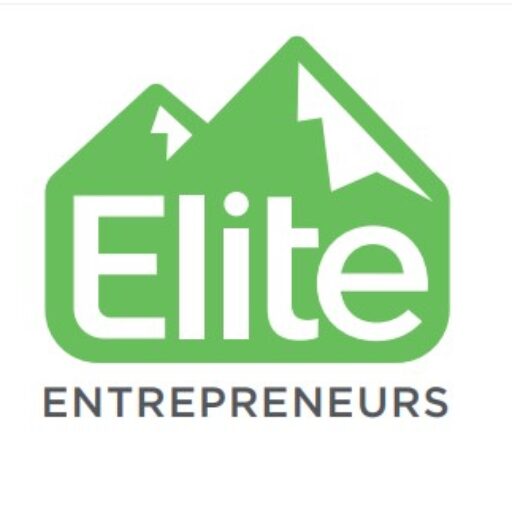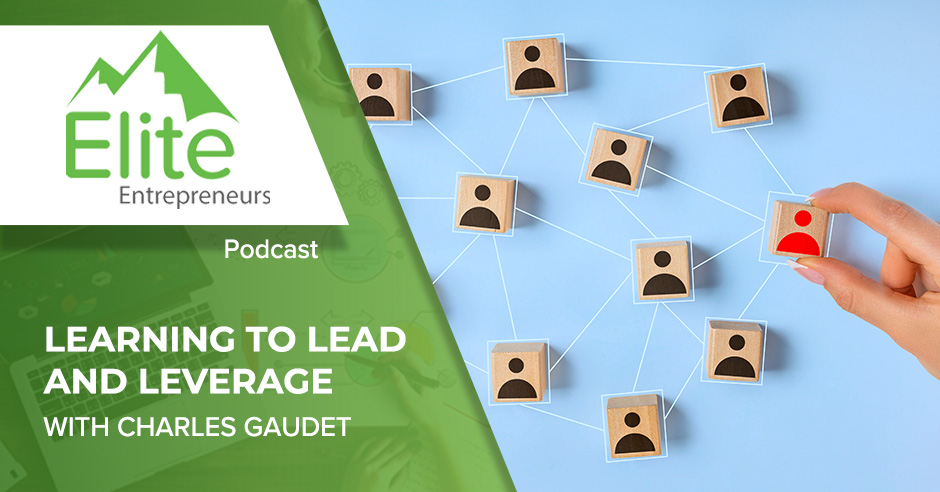Episode 112: Learning to Lead and Leverage, with Charles Gaudet
Charles Gaudet is the author of “The Predictable Profits Playbook: The Entrepreneur’s Guide to Dominating Any Market and Staying on Top“ (voted #1 Book on Sales & Marketing by Indie Excellence) and host of The Beyond 7-Figures Podcast.
The International Business Times called him “The Go-To Business Coach for 7 and 8 Figure Businesses” and perhaps the “busiest sales coach in the US.“
GritDaily said Gaudet is: “regarded in entrepreneurial circles as one of the top coaches for helping entrepreneurs surpass the seven and eight-figure mark.”
And Yahoo Finance referred to him as: “The CEO Whisperer.”
He’s been an entrepreneur since the age of 4, created his first multi-million dollar business at 24, and has helped others generate millions with his strategies.
He’s received numerous awards and recognition (including founding a company named as “One of the Best Seed Stage Companies” by Ernst & Young), received his Certificate of Leadership Development from The US Army War College and has his business advice featured around in the world – including Inc., Forbes, Salesforce, Success, Entrepreneur, and Fox Business – as well as on podcasts and radio.
He was named one of American Geniuses’ Top 50 Industry Influencers.
He trains in Brazilian Jiu-Jitsu (two gold medal finishes) and is a 3-time wrestling state champion. He lives in New Hampshire with his beautiful wife, three adorable kid-preneurs, and one badass dog.
What You Will Learn:
- How Charles learned that everything changes in your business once you reach seven figures, and why leveraging your resources is crucial for moving to the next level
- Why getting more sales is only effective when you have the systems and team in place to deliver on those sales
- Why strategically simplifying your business at the seven-figure revenue plateau is the key to resuming growth
- How creating an overarching system specifically designed for creating systems in your business can be a powerful strategy for accelerating your growth
- Why, like a train, it takes four key parts to operate and scale a business (cogs, engine, engineer, and visionary)
- Why building out an effective leadership team can help you move from being the engine driving your business to being the engineer navigating
- Why when you’re just starting, you have to hustle and do everything, and why scaling means doing less or even none of what you’re doing now
- Why it’s important to remember that hiring great people is only the first step and that you must then support them and set them up for success
- Why hiring someone with all your same skills results in one of you becoming redundant, and why hiring for key specialties and skills is more effective in the long run
- Why a three-pronged strategy of optimization, systemization, and innovation is the key to getting to eight figures and beyond
Resources:
- Beyond 7 Figurespodcast: https://predictableprofits.com/beyond-7-figures/
- Website: https://predictableprofits.com/
- LinkedIn: linkedin.com/in/charlesgaudet/
- LinkedIn: linkedin.com/company/predictable-profits
- Facebook: facebook.com/PredictableProfits/
- Twitter: @charlesgaudet
Additional Resources:
- Elite Business Health Assessment: https://growwithelite.com/health
- Email: info@GrowWithElite.com
- Website: https://growwithelite.com/
—
Listen to the podcast here
I have a fun and exciting guest because Charles Gaudet, who is our guest, has a podcast. I feel like the energy inside of me is just ready to geek out. Let me tell you a little bit about Charles. Charles Gaudet is the CEO and Founder of Predictable Profits. He wrote a book similar to that name. It’s called The Predictable Profits Playbook: The Entrepreneurs Guide to Dominating Any Market and Staying on Top. I mentioned the other podcast that is similar to ours. Charles has a podcast. He’s the host of the Beyond 7-Figures Podcast. It is super interesting how parallel or how similar it is in what we’re trying to do. I got to shut up and just welcome you. Thank you, Charles, for being here.
It’s a pleasure to be here. Just as you said, having the opportunity to geek out, a lot of what you and I do is somewhat similar, but we both have different experiences. We’ve learned from different people and different mentors. It’s inevitable that throughout this conversation, we’re both going to be able to play ball and share insights and ideas that are not only going to enrich you and me and our relationship but also that of the readers. I’m excited to be here.
I love the abundant mindset that you bring to the conversation. It could be easy for people in our shoes to go, “Their podcast is like mine.” We can get a little competitive around that, but that doesn’t serve anyone. There are millions of business owners out there who need what you do and what I do. We’re just thrilled to be able to share.
Charles, you are not only an expert in this space, but you’ve personally experienced it. I know you’ll weave in and out of those two roles. Those are two parts of who you are. As much as possible, I’m going to bring you back to your own experience in scaling a business through that seven-figure range because that’s what our readers are tuning in for.
Tell us how to get through some of these things where they get stuck. If you can think back to the early days when you got to that seven-figure mark and maybe the first time you realize, “There’s a new game here. There’s something different that starts to happen. It’s not just about getting another customer. We got to start building a team and doing this business-building work and all that.” If you think back to that time, what first occurred to you that this is different than what we’ve done to get to this point?
The first symptom of being changed as required is you start dancing this fine line of wanting more clients but, at the same time, not being able to service all the clients. It’s like, “What do I do because I can only work so many hours?” A lot of that came from that startup mentality that many business owners have carried into that early seven-figure mark, which is just hard work, grit, and determination.
The formula for achieving any goal is actions plus resources equal goal when, in the beginning, in that startup, we don’t have any resources. It’s just action and action. Now that we’ve made our first seven figures, we have resources but we’re not conditioned or trained to think in terms of how we leverage these resources to create more opportunity.
We make decisions out of desperation or inspiration. At the time, for me, dancing that fine line of wanting more business but not having the bandwidth to do it, you finally have to make a decision, which is, “I’m going to need to either expand my team and/or create systems and/or create processes and whatnot, but somehow find ways to create that leverage.” Leverage is what helps take us from that one point over to the next level and continue beyond that.
As I was reading some of your bio, it talks about you being the go-to business coach for 7 and 8-figure businesses. Perhaps, the busiest sales coach in the US. I love that your answer wasn’t necessarily about, “I got to get more sales.” You do how to get sales. You know sales. That bouncing after you talked about is like, “I can’t sell any more until I figure out how to fulfill more. There’s only so much of me.”
There are points of leverage as you pointed out critical transition for any business owner who’s trying to go to that next level. I would even introduce the word investor to what you’re trying to describe. Before that, we’re very much trading time our own self to make this thing go. Now, you got a few resources like you said, “How do I invest those to get the most leverage?” That’s a different game. Why don’t you walk us through some of the initial things that you did or things you tried that gave you a little more leverage or allowed you to get out of the formula of delivering everything, so that you could do more as a business?
First is a change of mindset. In the beginning, it’s a growth mindset. You’re so worried about, “Where am I going to come up with enough money to pay myself this week?” and then, “To pay my bills this month?” It’s a growth almost at-all-cost type of mentality. Typically, you’re taking on any job that would pay you. You’re taking on any client that would be willing to give you money, whether or not they are an ideal client.
As you continue to grow, you go into this mentality of you go from growth, and then you have one word in front of that, which is sustainable growth. You go from a very complex type of six-figure situation, where you’re taking on everything and every client. You then simplify and realize, “I’m only going to work with these people. I’m not going to do all this other stuff that I’m doing. I’m only going to focus on this amount.” To answer your question in terms of where we are investing, now that you’ve simplified, it’s much easier to be able to scale and to bring in people on a simple organization because, from a sales perspective, it’s easier to teach people how to sell 1, 2 or 3 things rather than throw the whole smorgasbord of stuff.

Leveraging Resources: By simplifying your business, it is much easier to scale, bring in people, and sell your offers instead of throwing the whole smorgasbord.
The sky’s the limit.
“We do everything. Now, figure out a way to sell it.” That doesn’t work. Steve Jobs did this when he came back as CEO for the second time. He’s like, “Look at all these SKUs. We’re going to get rid of most of them. We’re going to simplify them.” Simplification is part of the reason why they were the first business to reach a trillion-dollar valuation.
When you talked about simplifying so that you could invest, I couldn’t help but think of the word strategic or strategy. Up to this point, I love how you described the common thing for business owners is just to say yes to whatever opportunities come their way at first. It’s like, “We’ll do that.” To simplify, it’s the first time that we don’t always associate it with the word strategic. We’re saying, “Of all the possible things we could do, we got to start saying no to the wrong customers.” You can powerfully say yes to the right opportunities. The simplicity allows the scaling, like you described so beautifully. I don’t know if that helped you get back to where you want it to be.
It did. I appreciate it. When we look at going beyond seven figures, if we start with the first hire we ever make, for myself, it’s intimidating. I knew I needed to hire somebody, but I started running through all these scenarios. I don’t know what I would tell them to do or I falsely believed I was the only one who could do this. We start making this big elephant in our minds as to what it’s going to take. Then comes the old question, “How do you eat an elephant?” To the untrained individual, they’ll say it’s impossible to somebody who’s a little more strategic to use the word, “One bite at a time.” Over time, you’ll eat the elephant. When I hired my very first person who was my assistant, for me, it was, “I don’t really know why I’m going to have this person to do. I’m going to hire a remote team. I’m going to have them ten hours per month.” I use that ten hours a week. I then was like, “Wait a minute.” We then went to 40, 60, to 80. Now, I have a team of assistants.
A funny thing happens with entrepreneurs, too, if you start one bite at a time. That’s enough not to overwhelm you. You’re going to find a way to best optimize and utilize that person, especially, when you approach it with the mindset of, “As we go ahead and we do this, I’m going to do this intelligently and through a very systematic process-driven approach.” Let’s say we’re working on the same team. If I’m going to assign something to you, the first thing I’m going to do is I’m going to record a video that’s going to explain what it is that we’re doing. I’m going to ask you because I got too many things going on. I’m the founder and the CEO. I’m going to ask you to please create a process or a system based on certain parameters to ensure that I understand that you understand what it is that we’re trying to accomplish. We build a culture of building systems. The only system that I’ve had to create is how to build a system.
When running your business, start one bite at a time to avoid overwhelming yourself. Share on XThe system of giving ownership to others.
The system up systems. If you and I are working together, I’ll say, “Brett, let me walk you through this. I’m going to do it once,” and then I’m going to ask you to create the system in the process to make sure we’re on the same page. You create this system and process. Let me say, “Awesome, that looks great. I need you to follow it.” You follow it. You check back to make sure it’s consistent. You go, “This is great.” You then have that process. It becomes an asset of the business. It has real tangible worth that gets loaded inside the company Wiki.
The beautiful thing is when I say building a tangible worth, if I later want to go and buy this business, if I’m an investor and I want to go buy this business, if you’re telling me, “Charlie, I’ve got this business in a box. It’s all set up and it’s ready,” for me, I’m willing to pay a higher multiple for a business in a box rather than having to walk in and sit down with the business owner and the key employees and say, “What is it that you’re doing?” and try to extract all that knowledge out of your head into a system so the company isn’t too dependent on any one person.
People might get it intuitively, but they have a really hard time doing it and making it happen with this idea of turning a process into a system that’s documented and repeatable. That’s now an asset that that business owns. That’s not transferable to somebody else, and it has real value. That’s a tremendous worth.
A lot of business owners never quite get there because they feel they’re too integral to everything. They got to make sure all happens. They don’t really have a transferable asset. When it’s time to move on, they can’t pass that on to somebody. It is not as valuable as it could be if they had done this work that you’re describing.
They sell the business and become a high-paid employee or the new owner.
I see that way too much. I love what you’re saying about your own experience there. In order to get rid of work off of your plate that allowed you to have more leverage to do other higher-value activities, you started bringing in team members. You systematized the process of creating systems. All of a sudden, your team is multiplying, but it’s not just about payroll adding up. It’s about the cumulative output that we can create together, which before you couldn’t do all that yourself and your business started to grow. Is it fair to say that your business only grows one person at a time? Is that a fair way to look at it?
To some extent, yes. Also, we can look at it to say in the beginning, it’s one person at a time until you have other people as you start building out that executive suite and building on a management team and executive suite. You can empower them on how to hire the right people. Now, you might have a COO, the CRO, a CMO, and different people building out the team.

Leveraging Resources: Building on a management team and executive suite will allow you to empower them on how to hire the right people.
A really good friend of mine, his name is Ari Maizel. He came up with this metaphor that I’ve used countless times with my clients that I felt was brilliant. It clarified a lot of things for me. He uses this metaphor of a train. In a train, he looks at it and breaks it into four compartments to operate a train. He says, “You got cogs, an engine, an engineer, and then you have the visionary.”
When you’re a 6-figure business, you have the COGS, the engine, the engineer, and the visionary. The cogs are the things that show up every single day. They do repetitive tasks over and over again. They’re essential to the operation of the train, but it’s repetitive tasks over and over again. Generally speaking, they require the lowest amount of highly-trained skills.
Now, as our company begins to grow and as there are constraints in our time, one of the first things that we have to look at as we analyze our time is how do we remove that cog behavior into behavior that becomes a higher level of skill? The first people that we’re going to hire are going to be those cogs to remove those cogs so that we can focus on higher-paid, higher-skilled labor, which oftentimes is us. We hire the cogs and then we’re the engine, we’re the engineer, and we’re the visionary. The engine itself again has a higher level of skill. The engine is what manages those cogs and keeps the train moving forward. The cogs keep it on the rails. The engine is what drives it forward, but it’s still a limited amount of train skill and ability. Ultimately, to graduate from that point, we become the engineer.
The beautiful thing about the engineer is you can have multiple engines. You’ve seen those trains that have one engine and then maybe another one and then a couple in the back for those big trains. The engineer is like, “We have enough fuel.” They’re much more strategic. They’re like, “We have enough fuel to get from here to here. Here’s the path that we need to take in order for us to get here on time.” There’s a lot more strategic decision and whatnot that goes into it.
Entrepreneurs, when you’re at the 7-figure level, oftentimes you’re spending most of your time as the engineer and as the visionary. That’s where you get to that eight figures and multiples of eight figures. Over time again, when you want to take your company even bigger to many multiples of eight figures, you say, “I need to get out of spending so much time as the engineer. I’ll focus most of my time as a visionary.” When you’re the visionary, you have multiple trains that are all going all the same time. You just set the strategic direction for the engineers. They go, but you get to stay as a visionary. That’s the ultimate goal and objective that we want to get to and the different phases as we graduate from startup to 6, 7, and multiple of 8.
When you are a visionary, you can manage multiple helms at the same time and set a strategic direction for your team. Share on XThat’s awesome. I love it. Thank you for sharing that. You said Ari is the one who shared that.
Ari Maizel. I wish I could claim that for myself, but I got to get credit where credit is due.
That’s a great one. I have to share a little analogy we use for some of those shifts, but I love that one. I want to circle back to something you said because it’s part of becoming an engineer. Part of moving from engine to engineer is assembling that leadership team. When the business first starts, the entrepreneur, he or she is the leader. At some point, there may be 6, 8, or 10 people who report to them before they get another leader in there. How essential is it in your mind in this seven-figure growth journey to start adding leadership pieces to the team, so that you can do more? What did that look like? How essential is that to your scaling to eight figures?
If this was a client who asked me this question, I’d be responding by asking, “How badly do you want to grow?” The thing is, as your ship gets bigger, you can’t expect to be the captain, control the engine room, control the kitchen, and control all these other elements. The more you try to dilute yourself, the less effective you’re going to be. It becomes increasingly more dangerous as you begin to weather different challenges and so forth. You need to be focused. We’ve got the saying that, “Dilution is not the solution.” I’m going to say solely focus on that.

Leveraging Resources: The more you try to dilute yourself, the less effective your team will be in handling different challenges that come along the way.
You start to build a leadership team. Think back on the first time you hired a capable leader. At first, it was hard for you to give little cog-level tasks away. All of a sudden, now you’re giving full engine levels responsibilities to somebody. How difficult was that? How did you make sure you got it right? What was the transition like to get that person fully on board with you and pulling together?
From what I understand about all the work that you do, if I had you as a mentor when I started earlier on, I wouldn’t have fallen on my face as much as I did. In the beginning, when I was hiring people, I was just hiring people based on some experience that they had on their resume. They come on the team and I’d be like, “Awesome. This is great. Now, figure it out” or bring them on board and I’d expect that I’m going to create a clone of myself. Then, I’m like, “Welcome. Now, figure it out. Here’s what we want to do. We want to make more money.”
When that doesn’t work out and it consistently fails over and over again, it’s like that definition of insanity, doing the same thing over and over again expecting different results. For me, that’s when I had to hire my own coaches because I’m like, “I can only bang my head up against the wall so many times before that’s it.” I got so frustrated. I didn’t understand what was going on. I thought I was doing everything right by hiring the smartest people because it’s not what you did.
It took me years to figure out how to create the business that I created. I can’t assume that just by hiring somebody that they would automatically know how to do it, number one. That’s the first problem. That’s why we think about systems, processes, and whatnot because that allows you to set somebody up for success. You’re giving them a playbook, “Here’s the playbook for your role.” That allows them to set up for success.
Number two, the other problem is if two people are identically the same, then one of them is redundant. It wasn’t a matter of cloning myself because that makes one of us redundant. I’m better off hiring a specialist for a particular role, whether that particular role is operations, marketing, or whatever it is. “Here’s your specialty. Here’s your playbook.” We then govern and manage according to a very specific KPI so that they understand, “If you want to succeed, this is your definition of success.” It is very specific and measurable.
It’s something that we can work towards collectively because my goal as the leader then becomes, “How do I make my team members as successful as possible in their role to hit their KPI?” That’s it. There’s a different mindset. The mindset of Charlie 1.0 was, “I’m going to hire somebody. Here’s your quota. If you don’t make it, you’re fired.” It’s that simple.
Charlie 2.0 now brings somebody on and I’ve changed my mindset. It’s, “Now that I have brought you into the organization, I have assumed the responsibility to help you become as successful as possible within this role. Anything shy of that is my failure, assuming that you are coachable and you do the agreed-upon activities that are necessary for you to succeed.” My whole role is bringing out the best.
I had this conversation coincidentally enough with my sister. It was an interesting conversation, where I said, “As you’re starting this organization, you are that doer. You’re doing everything. As you grow to scale, the interesting thing is that you’re going to be doing a lot less. In fact, you may have eventually been doing none of what you’re doing now. You’re going to be leading. You’re going to be managing. You’re going to create this vision for what the next operation or opportunity is.”
I hear you saying you had to get clear first about what you were going to give to these people. It’s hard to hire for something that you don’t have clarity on. Once you have them in there, your whole job is to help them be successful. Doing the things that you guys both agreed would be a good fit for them in that role and then in the KPIs. That’s such a huge transition for people as they go from hiring somebody who they hope will just take it without any support on their part like, “I’m the business owner. I need help over here. You say you know how to do this stuff, so I’m just giving it to you. Go.”
It sounds great for the business owner but that doesn’t work because they didn’t get clear first about exactly what was needed, how it would be measured, and how it aligns with the company goals. Until you get that level of clarity, you can’t give good ownership to somebody and then support them right at it. Everything you’re saying, I’m like, “We could have a whole interview about that.” I’m catching myself because I’m like, “I like Charles more and more, the longer we talk.” I could talk to you forever and we don’t have forever, but we can do this again sometime. I can have you back.
I’m having you on mine, as well. I get to pick your brain next.
We’ll flip it around. That will be great. You’ve already given so many wonderful insights into the journey. As we wrap this up, is there something that you can give to us that gives us permission to learn and grow and make some mistakes along the way? You said Charlie 1.0 wasn’t the same as Charlie 2.0. You then confessed Charlie 200.0, which is the way it is. How do you give yourself a little bit of grace in the growth journey there because we all need some of that? Not as an excuse to not do the work, but to allow ourselves to have Charlie 200.0. What would you say to that as we wrap up?
It’s going to be a two-part answer. The first part answer is mindset is critical. Every time we encounter a challenge and obstacle or whatnot, I’ve learned that I need to stop and ask myself, “Why is this challenge the best thing that could have happened in my business?” The more I continue to ask that question, the more I begin to see the opportunities that the challenge provided me, and it’s done wonders.
Every time you encounter a challenge or obstacle, ask yourself why it is the best thing that could have happened in your business. Share on XEven when 2020 happened, immediately, I kept asking, “Why is this situation the best thing that could have ever happened to my company now?” It provided a whole lineup of strategies and opportunities that we never would have otherwise seen and the results have shown for. Mindset is everything. We’re never going to be right 100% of the time.
That leads us to that second part, which is the strategy for taking a company from a marketing and sales point and so forth to a multiple of 7 figures and 8 figures and multiples of 8 figures and whatnot are three-pronged. It’s optimization, systemization, and innovation. The concept behind optimization is first, you just got to do something. When you do something through optimization, you have to ask yourself what’s working and what’s not working. As you see what’s working, the very simple formula is, “Let’s do more of what’s working.” In what’s not working, you either eliminate or you improve. The funny thing is optimization is a strategy that can work regardless of the size of your company.
We’ve got clients doing hundreds of millions of dollars and they’re still focused on optimization, systemization, and innovation. You then continue that cycle. As you innovate something new, you go back to optimization systemization, and innovation. Every single time I fell on my face, I was, “Which part works and which part doesn’t?” You and I can agree on one thing, we’re learning something new every single day.
Also, the people who aren’t growing or the people who don’t bring intentionality to what it is that they’ve learned, “I encountered this challenge or I had this victory. What works and what didn’t?” It brings intentionality into the action so you have the power. Clarity equals power. You have the clarity or the power to be able to expand on those strategies. “This worked. We’re going to do this.” That goes in your playbook.
Mindset and optimize, systematize, and innovate. Those would be the ways that you continue to learn and grow along the way. Charles, this has been wonderful. I do mean it. We should have a part 2 or a part 3 or whatever. We’ll keep having a series of these at some point off and on over the next several months because what you do and what you’ve learned is exactly the kind of thing that our folks need. Tell them how to listen to your podcast. Tell them how to connect with you if they want to learn more. Please give us ways to connect with you.
The podcast is Beyond 7-Figures Podcast. It’s on all the popular podcast networks. Soon, you’ll be able to hear Brett on that podcast as well. That will be a great opportunity for our audience. You can also visit us over at PredictableProfits.com. We also have a free business coaching opportunity there. They could put their email address and get a whole bunch of videos and whatnot, which would be fun. That would be the best way to get a hold of my hand.
It is PredictableProfits.com and the Beyond 7-Figures Podcast, which I am looking forward to being a guest on. That will be fun. Charles, this has been wonderful. Thank you again for spending time with us. I am so gracious of you to do that.
It’s my pleasure.
For all of you reading, please share, review, and like. Do all those things so that as many seven-figure business owners as possible can hear from Charles and all the wisdom that he dropped. That was fantastic. Go back and read this again and again, but more than reading, you got to do some stuff with it. Take some of the things that he generously shared and take some action. Be with us next time as we continue to bring you great guests like Charles. We want to help as many of you as possible achieve the business of your dreams. Thanks for reading. We’ll see you next episode.
Important Links
- Predictable Profits
- The Predictable Profits Playbook: The Entrepreneurs Guide to Dominating Any Market and Staying on Top
- Beyond 7-Figures Podcast
Want to listen to more? View all episodes here >



